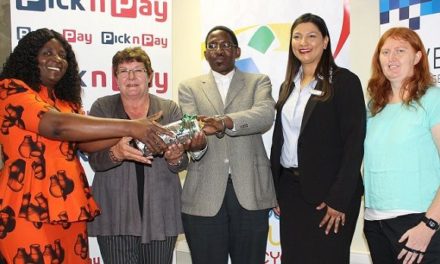
Namdeb receives heritage accolade

Dr Dieter Noli, contracted archaeologist, and Gully Muteka viewing some of the elephant tusks found on the shipwreck site at U60 in Mining Area 1.
This award is presented to companies that have contributed significantly to the protection of natural and cultural heritage on the African continent.
Namdeb CEO, Inge Zaamwani-Kamwi, received the award at a breakfast meeting hosted by the Patron of the African World Heritage Fund, Phuthuma Nhleko, and the Chairperson of the African Union, Dr Nkosazana Dlamini Zuma, in Midrand, South Africa on 6 May.
The shipwreck is believed to be the remains of a Portuguese trading ship that was sailing to India when it sank off the Namibian coast. According to the October 2009 issue of National Geographic magazine, Portuguese maritime archaeologists concluded that the wreck is probably that of the Bom Jesus, the ‘Good Jesus’, which was part of a fleet of trading ships sent from Portugal to India in 1533.
The Bom Jesus was owned by Portugal’s King João III.
The shipwreck was discovered in Namdeb’s Mining Area 1 (MA1), some 18 km north of Oranjemund by Kapaandu Shatika, a dozer operator at Namdeb. On the morning of 1 April 2008, in the course of his mining excavation work, Shatika unintentionally exposed the shipwreck material in the form of wood, copper ingots and two cannons.
Some 5438 artefacts of immense cultural, scientific and intrinsic value were subsequently recovered. These include 2159 gold coins, 1845 copper ingots, 109 silver coins, 67 elephant tusks, 14 cannonballs, eight bronze cannons, five anchors, three astrolabes, three navigational dividers and part of the ship’s compass, as well as pewter tableware, copper cooking utensils, swords, muskets and chain mail. The copper weighed about 20 tons, together with about three and a half tons of tin.
Several wrought iron cannons, swords, muskets and a box of sword blades, all of which were locked in concretions were left in situ, as were the wooden structural remains of the ship that had been exposed.
Namdeb donated one of its engineering workshops in Oranjemund to serve as the holding place for the artefacts, where they are being preserved under the auspices of the Ministry of Youth, Culture and Sports.
Commenting on the award, Zaamwani-Kamwi said, “We are delighted to be the recipient of such a prestigious award. Whilst this award is in recognition for the outstanding job we did in managing the shipwreck find and its preservation, we pride ourselves for our overall track-record on environmental management and conversation programmes.”












































